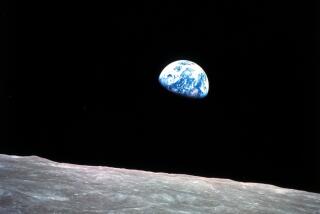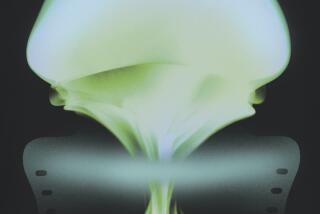Truly Cosmic Experiences : UC San Diego Chemist Has Had Meteoric Career Studying Outer Space
- Share via
LA JOLLA — For Jim Arnold, life without outer space would be hard to fathom. The popular chemist at the University of California, San Diego, even has an asteroid--”2143 Jim-arnold”--named for him.
Arnold has spent most of his life--and more than a quarter century at UC San Diego--considering myriad questions about our universe, from cosmic rays to the future of space flight.
His laboratory’s work on lunar rock samples has helped to determine the age of the moon more precisely than ever before, as well as to trace the history of the sun back millions of years. As director of the UC California Space Institute, Arnold identifies promising young scientists whose projects on the leading edge of new technologies can further human exploits of the solar system. As a longtime consultant to the National Aeronautics and Space Administration, Arnold attempts to shape government space policy, sometimes successfully, sometimes less so.
But even ahead of his professional career--which began at Princeton University in the mid-1940s--Arnold traces his interest in the non-terrestrial to his childhood. He keeps a well-worn copy of the Omnibus Jules Verne behind the desk in his laboratory.
“I’ve owned it since I was 11, this collection of four science fiction novels,” the 63-year-old Arnold said during an interview last week. “The one particularly relevant here is the (1867) novel, ‘From the Earth to the Moon,’ which had a profound impression on me.”
In addition, Arnold had a boyhood ambition to become an astronomer that developed, he said, “after I decided I was not going to be a fireman.”
‘I Had a Bias’
“So from early on, I had a bias towards space.”
At Princeton, and then at the University of Chicago, Arnold geared his studies toward understanding the nuclei of chemical elements, which at the time represented the frontiers of science. He participated in the Manhattan (atom bomb) Project and then joined chemist William Libby at Chicago, where radioactive carbon dating was developed. That work earned Libby a Nobel Prize.
The technique, still widely used by anthropologists and paleontologists, looks at the radioactive decay of carbon isotopes that occur in nature, which takes place at a fairly constant rate. Approximate dating is possible if one knows the rate of decay and measures how much of the isotope has decayed in a particular object.
Arnold expanded the research to look at the effects on meteorites of cosmic rays, which are very high energy nuclei entering the solar system at all times from interstellar space as a result of processes not yet fully understood.
By looking for isotopes that would have a long decay--millions of years or more--it is possible to develop fossil records for a piece of the moon or of a meteorite.
“And you thus learn a lot about the history of the cosmic rays and how long a meteorite has been a rock in space and where it might have come from, all by exploiting the well-known properties of radioactive nuclei,” Arnold said.
Basic Information
In the last month, Arnold and his colleagues have determined, using powerful new techniques, the dates of terrestrial rocks by measuring isotopes in them that up until now could not be detected because their presence on Earth was too weak to detect. Earth’s atmosphere filters out most cosmic rays, protecting organisms from the most harmful effects of the powerful nuclei.
“We see it being used in the immediate future for measuring erosion rates, the rate of decay of mountains, on a worldwide or geographic scale, and think that is going to be one of the basic bits of information that one should know about the Earth,” he said.
The early work with cosmic rays took Arnold irretrievably into the arena of space, where he very much remains.
Soon after his first work with meteorites, the Soviet Union began the space race with its Sputnik satellite in 1957 and attention among Arnold’s colleagues immediately focused on how to apply nuclear techniques in space. Arnold, with encouragement from Harold Urey--a giant in the field of nuclear chemistry and in the formulation of theories about the solar system’s origins--persuaded NASA to determine the composition of the moon by measuring cosmic ray effects there.
“By then, I was hooked,” Arnold said.
Also by then, Arnold had arrived at UC San Diego, where he became an associate professor of chemistry in 1958 and a full professor and first chairman of the chemistry department in 1960.
His ultimate research goal is to push the record of the universe closer to its origins, and Arnold admits that the philosophical impact can cause goose bumps.
“I am intensely curious, of course--a necessary condition for being in my business--and I always try to fantasize where we haven’t yet the wit or tools to unlock all the secrets of solar system that I believe are already inside meteorites,” Arnold said.
“But I am also reminded that every day you have to do a day’s work, and the experiments you can do on a given single day are always very small.”
Arnold calls himself a generalist, enjoying projects that can be applied across many fields of science, such as carbon-14 dating. In that context, he has weathered well the give-and-take of the nation’s space bureaucracy through almost 30 years of service on various NASA committees.
“My first committee was in January, 1959, only three months after the space agency was established,” Arnold said.
Arnold is critical of NASA’s tendency over the years to tie up promising new ideas in a web of reviews and other delays that have had the effect of dulling its early reputation as a “can-do” agency. In part, the increasing bureaucracy has resulted from the need to tighten procedures after such disasters as the Apollo 7 and Challenger, in which astronauts died.
‘Another Study’
Arnold thinks NASA could move more quickly to explore innovative space technology, including alternatives to chemical rockets, like the ion engine under development in West Germany, that Arnold believes have reached the design limits of their potential to lift objects into space.
“We get some support from NASA for some of our studies (on new technologies), but after we finish, they say, ‘How would you like to do another study?’
“I do think that there is going to be more movement now that the President’s commission (on the future in space) has recommended that some of the next-generation technologies begin to come into their own.”
Arnold would also like to see more international cooperation on space projects as a way to spur research. But he cautions that the United States should not allow its technical pre-eminence to erode.
“I’m an American, and one likes to think well of one’s country,” he said. “The U.S. has been a leader since Apollo, although the Soviets have done better than we give them credit for, and I participate in these international technological Olympics with a certain degree of national feeling and enthusiasm . . . and I would be very unhappy personally if the U.S. were to fall far behind.”
Space Colonization
Arnold has a similar strong attachment to the idea of space colonization, hearkening back to his longstanding interest in the cosmos as well as his involvement with former Princeton physicist Gerry O’Neill, who sponsored seminars on how to mine resources in outer space and how and where colonies might be established.
Although Arnold has no particular expertise in aerospace matters, he has tried to set up similar seminars at UC San Diego to encourage young scientists to pursue questions of man’s future in space.
“Call it Jules Verne stuff or whatever, this question of expanding life into the solar system is of very great value in itself and for itself,” he said.
“It is of great benefit to humanity in the long run and, in some kind of sense, it is the only direction that the only intelligent life that I am aware of in the universe ought to go, exposing living things to environments very different from ours and creating civilizations elsewhere.”
At bottom, Arnold finds space issues the ultimate challenge.
“When I’m in Washington, and it’s been a grim time lobbying (with NASA and Congress), I go to the National Air and Space Museum and watch people of every age marveling at . . . the Wright brothers, Lindbergh, Goddard and Apollo, and I recharge my own batteries and say, ‘It can be done!’ ”






